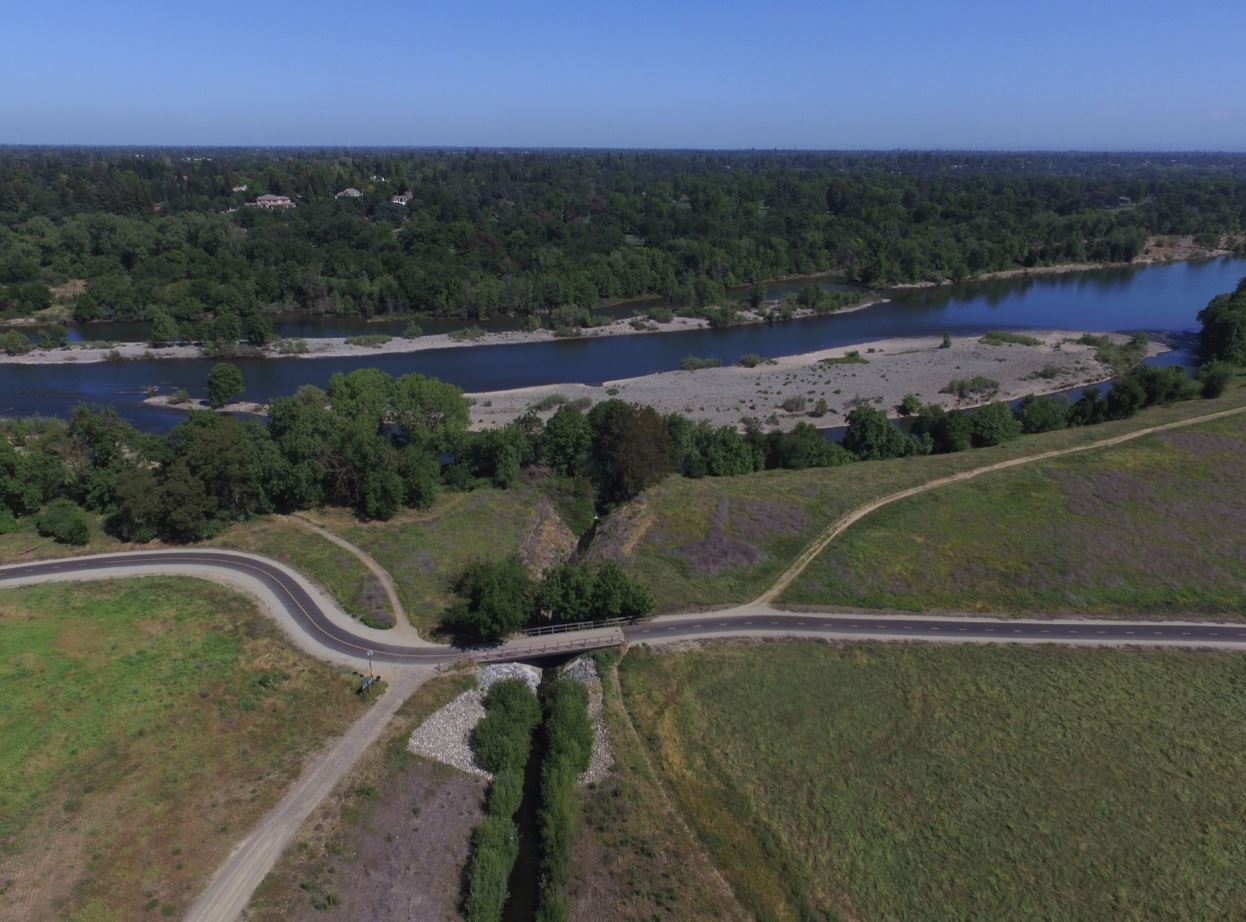
By Erica Bishop
The Water Forum is making strides to complete the naturalization of Cordova Creek, one of the few tributaries of the Lower American River with year-round water flow.
These flows, derived primarily from clean water outflows from Aerojet’s upstream groundwater treatment plant, make the creek especially important to the Parkway’s riparian plants, wildlife, and fish including juvenile salmon and steelhead. But, for decades, the creek has been accessible to fish only when American River flows are very high. That’s because the transition from creek to river is very steep, the result of a drainage ditch project in the last century that paved the creek in an attempt to reduce erosion.
In 2017, the Water Forum partnered with local and state agencies on naturalizing upstream portions of the creek. This involved adding some more natural bends to what had been a straight concrete-lined storm drain, adding cobble to stabilize the new stream channel, and planting willow trees and upland species along the creek’s margins.
The project was a win, as beavers quickly colonized the area. These native riparian rodents, long unfairly vilified, continued our work by building dams and a lodge, helping to slow and filter the water flow in the creek. The project attracts deer and a wide variety of birds, and it won an “Outstanding Environmental Stewardship” award from the Sacramento Environmental Commission.
Cordova Creek also has become a major asset for the community, which includes the adjoining Cordova Meadows neighborhood and Soil Born Farms, providing educational opportunities for Parkway visitors and local school groups to learn about the ecosystem, often led by the team at Soil Born Farms.

But, the final 400 feet of the project, where the creek connects to the American River, proved a bit more challenging. The naturalization must be planned carefully here, due to the steepness of the confluence and because the creek passes under a heavily traveled bike and pedestrian bridge that’s part of the American River Parkway’s trail system.
Now, after additional study, this final creek segment is nearly ready for construction. The project has reached the 65 percent design stage, and the Water Forum is ready to seek grant funding of around $5 million to complete permitting and pay for construction of our first multi-benefit project on the Parkway.
The project calls for removing concrete in the channel and building a series of boulder stepped pools from the river up into Cordova Creek. This will allow juvenile salmon to move both upstream and downstream between the creek and the river, even when American River flows are at their lowest. The step pools also help to make the project stable and sustainable—although Cordova Creek is small, this area is completely inundated by the American River when it floods and has to be built to withstand those conditions. Based on stakeholder input, the design ensures that large, native alders and other riparian trees growing near the existing concrete outlet will be preserved even after the creek is rerouted to its new channel.
When complete, this improved access will create an important resting and feeding area that may be used by juvenile salmon when they are small and vulnerable to predation. Areas like this are important for juveniles to access until they are large enough to migrate downriver to the ocean, and these habitats are very limited along the Lower American River.
The project also involves rebuilding the bike and pedestrian bridge for improved safety. This will include a bridge twice as wide as the current crossing, with a trailside viewing area and interpretive signs, where people can pause to appreciate the Parkway and creek. Since Parkway trails are also used by equestrians, the new bridge will be safe for horses, too.
Naturalization of this final portion will shift the creek confluence slightly downstream to an existing eddy in the river, an area of calmer water that’s already attractive to fish and does not dewater, even at low river flows. It’s also across the river from another Water Forum habitat project set to begin construction in summer 2023—a project that will continue our efforts to increase spawning and rearing habitat by improving the composition of riverbed gravels and adding side-channel and seasonal floodplain areas for salmonids to use in their home river.

The final phase of the creek project will also restore more than an acre of riparian and oak woodland habitat. The plan calls for planting 120 native trees, including oaks, walnuts, and other species that will help provide shade and attract other native wildlife. Parts of the project area currently support invasive, nonnative weeds such as yellow star thistle.
The Water Forum has worked closely with numerous partners on the Cordova Creek Phase 2 project, including the U.S. Fish and Wildlife Service, National Marine Fisheries Service, California Department of Fish and Wildlife, California Native Plant Society, Save the American River Association, Soil Born Farms, and several American River recreation groups to develop a design that serves multiple benefits on the Parkway. This phase of the project was funded by a grant from the California Wildlife Conservation Board and was cost-shared by the Water Forum, which includes a diverse group of environmental and citizen groups, business leaders, water agencies and local governments working together to balance water supply needs with protection of the Lower American River.
We hope to obtain permits for this last phase of Cordova Creek restoration in 2024, then finalize design and begin construction in 2025.
Erica Bishop is Program Manager, Habitat and Science, for the Water Forum.
